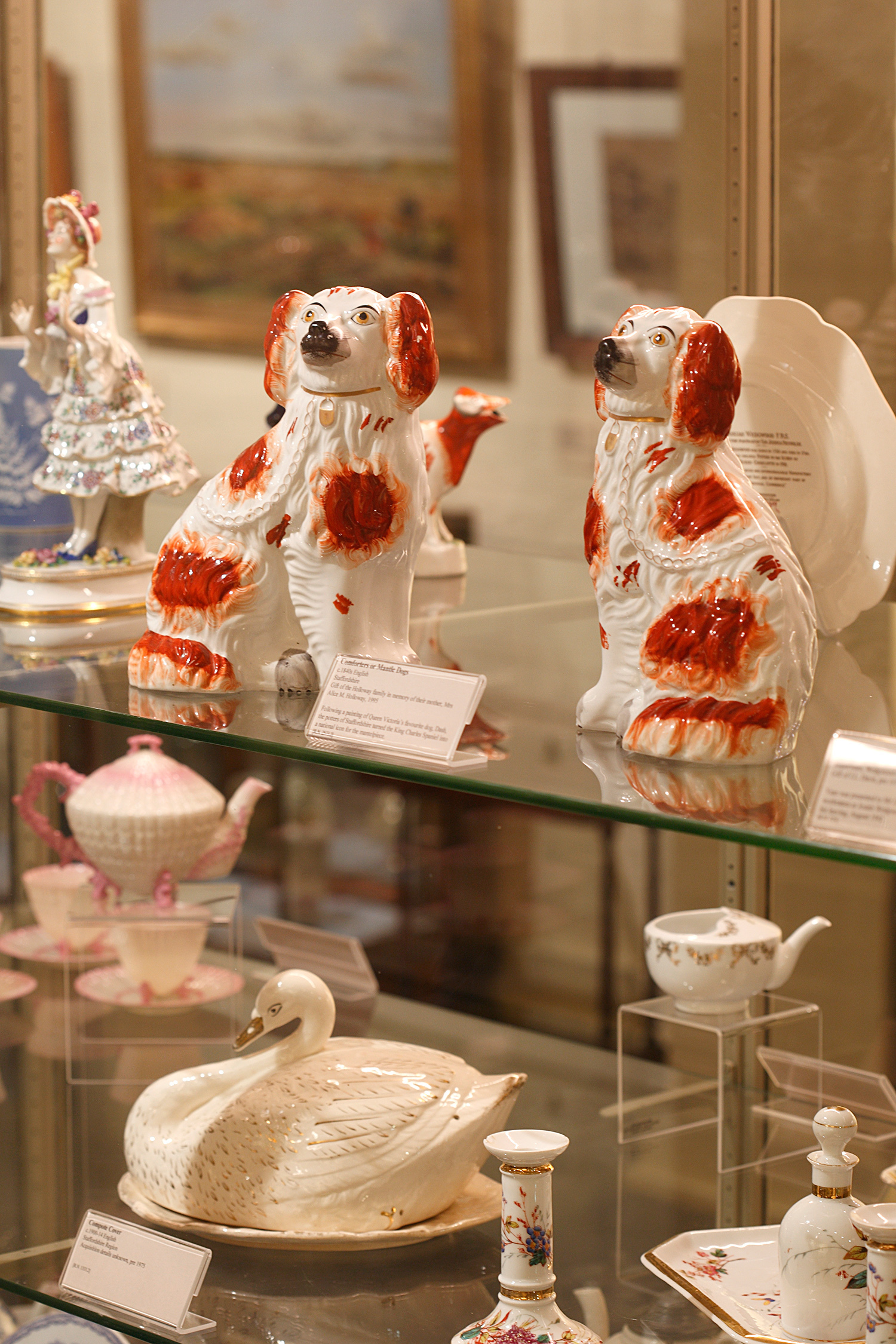Laird on Staffordshire Mantle Dogs
Local artist and writer Tessa Laird brings fresh eyes to a pair of porcelain mantle dogs in the CAM social history collection, which are currently on display in the museum and awaiting your return. Her response to these seemingly benign decorative pieces is a spirited reflection, mindful of our current times.

Laird on Staffordshire Mantle Dogs
Why is it that, on gaining entry into the hallowed halls of the Castlemaine Art Museum during lockdown, the work that spoke to me most was not a painting by Clarice Beckett or Penleigh Boyd but a pair of porcelain pooches? The kitsch couple looked up at me from their confinement, not just held down by their padlocked collars but penned in by their glass case. “Take us for a walk!” they seemed to beg.
Then I realised why it was that they struck me so—I had just seen their doppelgangers in the Castlemaine Botanical Gardens! The real-life fluffy pair had scampered along as fast as their tiny legs would carry them, and as far as their leads would allow, while their caged cousins seemed to lift their ears and snouts expectantly, hoping to be permitted some doggy freedom.
Many people have commented on the changing fortunes of dogs due to COVID-19. Mutts are the true winners of this zoonotic virus; their owners are constantly home, lavishing them with attention. Walking the dog is no longer a chore—it’s the highlight of the day for those people lucky enough to coexist with the companion species Canis familiaris.
I am not one of those people, and if I was, I’d choose a shorthair rather than a walking mophead. But still, there is something magnetically attractive about these wide-eyed Staffordshire mantel dogs, with their scumbled chestnut patches, and tails that, if they could wag, would make frenetic circles that would smash the rest of the china in their shared vitrine.
The label accompanying the work explains that these ceramic canines were based on Queen Victoria’s favourite dog, a King Charles Spaniel called Dash. It seems strange that a portrait of a singular dog was produced in pairs—identical but inverted so that one sits to the left and one to the right on the mantelpiece, possibly framing an important painting, clock or vase.
There is something eerie in this doubling—presaging cloning, perhaps? Or maybe this uncanny replication acknowledges the fact that, when a dog dies, it will most likely be succeeded with another of its kind? That, while they are adored during their lifetimes, we see them ultimately as replaceable?
I think the doubling has something to do with Chinese shishi or “foo dogs” as they are sometimes known in the West. These are lions carved out of stone to guard the entrance of tombs, temples or royal residences. But depending on the whimsy of the artist, shishi can be playful, even cuddly and cute, prompting European eyes to interpret them as fluffy dogs rather than lions. Shishi come in pairs because they exemplify yin yang, and there are subtle differences between them. The male lion paws a ball (certainly, a dog-like activity), while the female lion has a small cub underfoot. But the Staffordshire mantel dogs appear to be exactly alike— yet another important detail lost in translation from East to West.
If these two dogs are guardians, I wonder what they protect? Ideas of royalty, and of “good breeding”? Googling King Charles Spaniel yields much information about congenital diseases, prompting questions about the continuation of animal breeding despite its demonstrable cruelties. Further, ideas of duty and obedience are raised by the pooches’ padlocked collars and the delicate gold chains which hang from them. There may be love in the relationship between these dogs and their owner, but there is also servitude, echoing that of the good citizen for their sovereign. The yin to this yang isn’t in the vitrine but lives in the margins outside the museum: wild dogs, howling at the moon.
Tessa Laird
August 2020